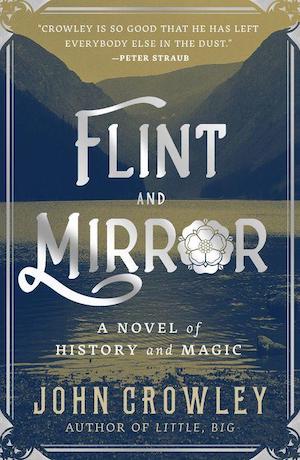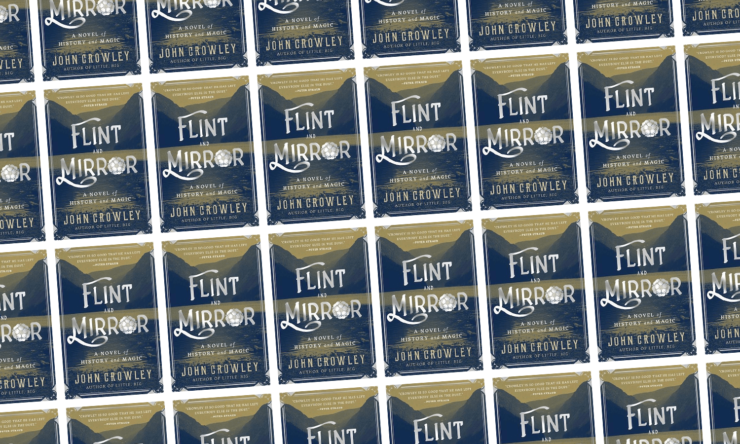In John Crowley’s 1981 masterpiece Little, Big, young Auberon Drinkwater daydreams of writing about Emperor Frederick Barbarossa. His work would feature “Saracens and papal armies, Sicilian guerrillas and potent palaces and princesses too,” but its secret purpose was to contemplate the emperor before his final battle. To Auberon, this “figure seen in a moment of repose snatched between two desperate actions, exhausted after victory or defeat, hard clothes stained with war and wear,” is an object of fascination. Neither Auberon Drinkwater nor his creator John Crowley ever wrote a Barbarossa play, but Crowley’s new novel, Flint and Mirror, evokes the feelings that Auberon dreamt about.
Flint and Mirror recounts the life of Hugh O’Neill, a sixteenth-century Irish earl forever torn between his native land and the English colonizers. Like almost all characters in this novel, he is drawn from history. Like almost all characters in this novel, he is obscure to contemporary Americans. In Ireland, paintings and statues commemorate him; in the United States, his name adorns a few pubs. To summarize: Hugh O’Neill was an Irish lord who, by dint of ambition, family name, political maneuvering, and statecraft, had a chance of uniting Ireland against its English administrators. Though he spent much of his youth in the English court, O’Neill eventually led a rebellion against Queen Elizabeth’s colonial forces; he won some battles, lost others, and eventually surrendered to the English. He was pardoned, but in 1607, he fled Ireland for Rome.
Crowley’s Hugh O’Neill is a man of divided allegiance and uncertain desire. He is an Ò Neill, “the O’Neill,” to his Irish compatriots; to the English and their sympathizers, he is the Earl of Tyrone. He speaks English and Irish equally well; he has dear friends and bitter enemies on either side of the Irish Sea. Hugh kneels before Elizabeth in London while dreaming of being crowned High King at Tara.
Buy the Book


Flint and Mirror
For most of his life, O’Neill carries two talismans of his conflicted loyalty. On the night before his first departure for England, he is led to an ancient barrow by a blind poet. There, the spirits of the land bestow on him a piece of flint; perhaps he might call up the spirits of the earth and air with it. Upon Hugh’s arrival in England, he is tutored by the alchemist and angelologist John Dee, who imparts to him an obsidian mirror that conveys to him Queen Elizabeth’s will. Though O’Neill at the last chooses his ancestors’ side, neither flint nor mirror ultimately serves him well. The novel is bookended with scenes of the elderly Hugh O’Neill, exiled in Rome and destined never to return. “Everyone agreed: It had grown colder in Rome in these latter days.”
Though he is willing to summon the occasional spirit, raise a ghost or two, and ascribe genuine mystical powers to the Virgin Queen’s magician John Dee, a historical figure so strange I always hesitate to believe he actually lived, Crowley does so within the outlines laid down by our actual history. In this novel, as in the actual Hugh O’Neill’s busy life, there are few constant companions and many passing acquaintances. This is a compact novel that elides much of Hugh O’Neill’s complicated biography. History records that Hugh had at least four wives; in Flint and Mirror, the first wife receives a brief paragraph’s mention, while the fourth wife goes unmentioned; the novel does not venture an opinion on the fifth wife that some historians suspect. Even so, it’s hard for those of us with sketchy knowledge of Elizabethan Ireland to keep track of the many and various earls, lords, generals, princes, and pontiffs who populate the book, to say nothing of the innumerable O’Hagans, O’Cahans, O’Neills, and O’Donnells. Nor does it help that Hugh O’Neill’s most stalwart companion was his nephew, also named Hugh!
In his Acknowledgments, Crowley describes Flint and Mirror as a “fix-up.” Much of the first chapter, about Hugh O’Neill’s youth in Ireland, his fostering in England, and his receipt of the flint, appeared in Crowley’s book And Go Like This, where it was described as an unfinished manuscript found in the estate of Fellowes Kraft, a novelist who features in Crowley’s Ægypt sequence. The story, suggestive and mysterious, was a highlight of Crowley’s last collection; it works even better as the beginning of a novel. Flint and Mirror also incorporates much of Crowley’s novelette “An Earthly Mother Sits and Sings,” his Joan Baez-inspired tale of a lonely Irish woman, the Spanish Armada, the pirate queen Grace O’Malley, and a silkie shapeshifter. The fix-up’s seams show here; for all its plangent Hibernian mistiness, the “Earthly Mother” material, which just barely intersects with Hugh’s story, diverts us from the novel’s central figure.
As Hugh’s Tale draws to its close, the spirits fail Hugh O’Neill and the angels depart from Dr. Dee: “They sailed to the West, to the Fortunate Isles, to coasts and faraway hills, to little woods and big that they had never known, that would perhaps come to exist only when they were reached.” That sentence, closely read, may inspire a chill in Crowley’s longtime readers, but even the newcomer to this great fantasist will understand that this is a recessional, a falling back and a fading away.
If Hugh’s life proves a failure, Crowley’s novel, as ever, is a success. Its 240 closely set pages boast a cast of hundreds, and Flint and Mirror makes relatively few concessions to the reader. There’s no map of sixteenth-century Ireland, no index of dramatis personae or glossary of Irish terminology. Flint and Mirror is unsparing and challenging. Like John Dee’s cryptic messages from the empyrean, it demands scrutiny and repays attention. These latter days may chill the soul, but Flint and Mirror warmed this reader.
Flint and Mirror is published by Tor Books.
Matt Keeley reads too much and watches too many movies. You can find him on Twitter at @mattkeeley.










